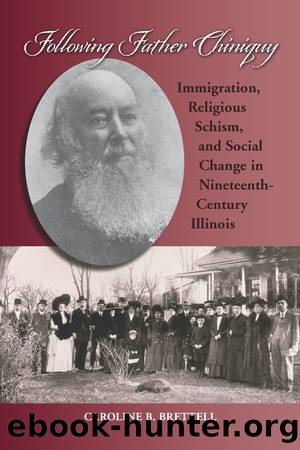Following Father Chiniquy by Brettell Caroline B.;

Author:Brettell, Caroline B.; [Brettell, Caroline B.]
Language: eng
Format: epub
Publisher: Southern Illinois University Press
An economic explanation emerges from oral historical material about the schism and from some documentary evidence that lends concrete confirmation to certain aspects of the oral historical interpretation. In 1858 and 1859, as indicated in chapter 2, St. Anne and the neighboring communities were hit by early frosts, unseasonable rains, and insect infestations that resulted in two successive years of poor harvests. A large proportion of the population experienced severe economic hardship. Chiniquy, as noted in an earlier chapter, seized the moment and organized a speaking tour to the East Coast to solicit funds, food, and clothing for his starving French Canadian converts, who had abandoned Catholicism but who had not yet become full-fledged Presbyterians. The community explanation for the demographic success of the schism is that many followed Chiniquy because he had the financial aid they needed during this period of severe hardship. It is clearly plausible that the poorer families and the families that suffered most during these two years of crop failures were the larger families with more small children. Thus, the child/woman ratios of the converts (the Protestants) in 1860 are higher than those of the nonconverts (the Catholics).
When we examine the data on wealth and property in 1860, another difference between the two groups emerges. Those who remained Catholic were somewhat better off than those who converted to Protestantism. Twenty-four percent of the Protestant heads of households had real property valued at $1,000 or more, compared with 37 percent of the Catholics. Thirty-seven percent of the Protestants had real property valued at under $100 compared with 21 percent of the Catholics. Roughly the same proportion of Protestants and Catholics had six or more children (of all ages) living at home (33.7 percent and 33.6 percent, respectively), but slightly more Protestant converts in 1860 (37 percent) had between three and five children than did Catholics (35 percent). The age composition of the male heads of household in the two populations may explain, at least in part, these wealth differences. Protestants males in 1860 were generally youngerâ52 percent were under thirty-five, and 25 percent were over fifty. Among the identifiable Catholic males in 1860, 45 percent were under thirty-five, and 31 percent were over fifty.
The 1900 census provides yet another measure of fertility. In this year, women were asked two questions related to their fertility: the number of children they had ever had and the number of children still surviving. Table 4.13 tabulates the data for all currently married women over age forty-five in 1900 by reported number of children ever had and religious affiliation. Table 4.14 tabulates the data for all currently married women under age forty-five by number of years at risk, number of children ever had, and religious affiliation.
For both the over forty-five and the under forty-five categories, there appears to be a difference between Catholic women and Protestant women, with the latter group consistently reporting fewer children ever had. The mean number of children ever had for the overall population is 4.8; for the Catholic subpopulation, it is 6.
Download
This site does not store any files on its server. We only index and link to content provided by other sites. Please contact the content providers to delete copyright contents if any and email us, we'll remove relevant links or contents immediately.
The Vikings: Conquering England, France, and Ireland by Wernick Robert(79222)
Ali Pasha, Lion of Ioannina by Eugenia Russell & Eugenia Russell(39941)
The Vikings: Discoverers of a New World by Wernick Robert(36831)
The Conquerors (The Winning of America Series Book 3) by Eckert Allan W(36715)
Cecilia; Or, Memoirs of an Heiress — Volume 1 by Fanny Burney(32093)
Cecilia; Or, Memoirs of an Heiress — Volume 3 by Fanny Burney(31481)
Cecilia; Or, Memoirs of an Heiress — Volume 2 by Fanny Burney(31435)
Empire of the Sikhs by Patwant Singh(22780)
Hans Sturm: A Soldier's Odyssey on the Eastern Front by Gordon Williamson(18341)
The Secret History by Donna Tartt(18269)
Cat's cradle by Kurt Vonnegut(14804)
Sapiens: A Brief History of Humankind by Yuval Noah Harari(14006)
Pimp by Iceberg Slim(13828)
Talking to Strangers by Malcolm Gladwell(12916)
Norse Mythology by Gaiman Neil(12880)
Leonardo da Vinci by Walter Isaacson(12834)
Underground: A Human History of the Worlds Beneath Our Feet by Will Hunt(11857)
4 3 2 1: A Novel by Paul Auster(11843)
The Radium Girls by Kate Moore(11652)
